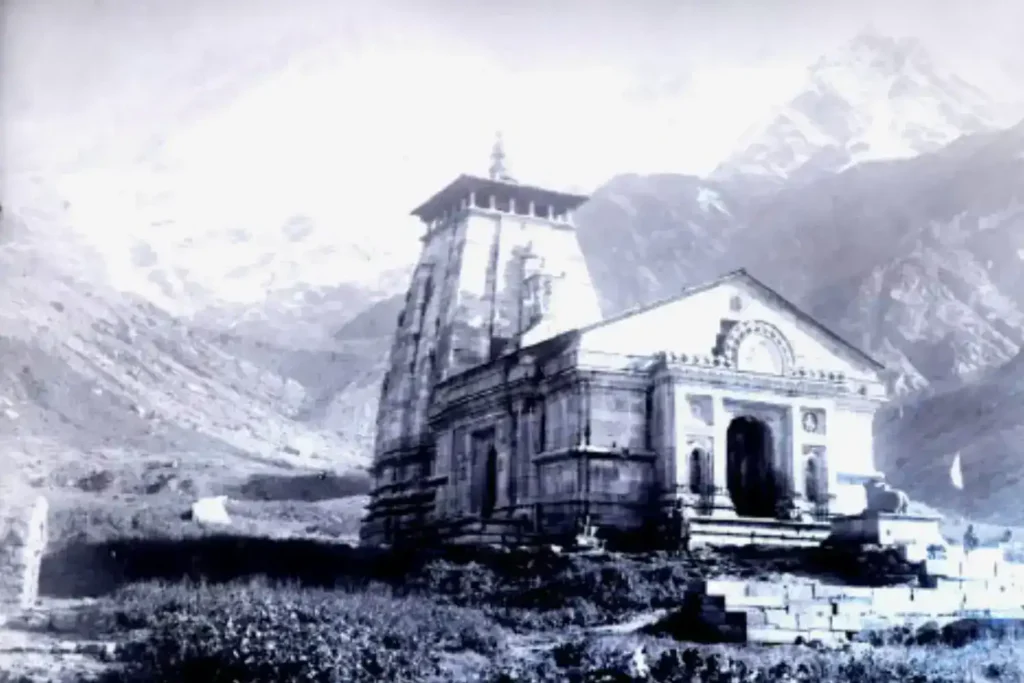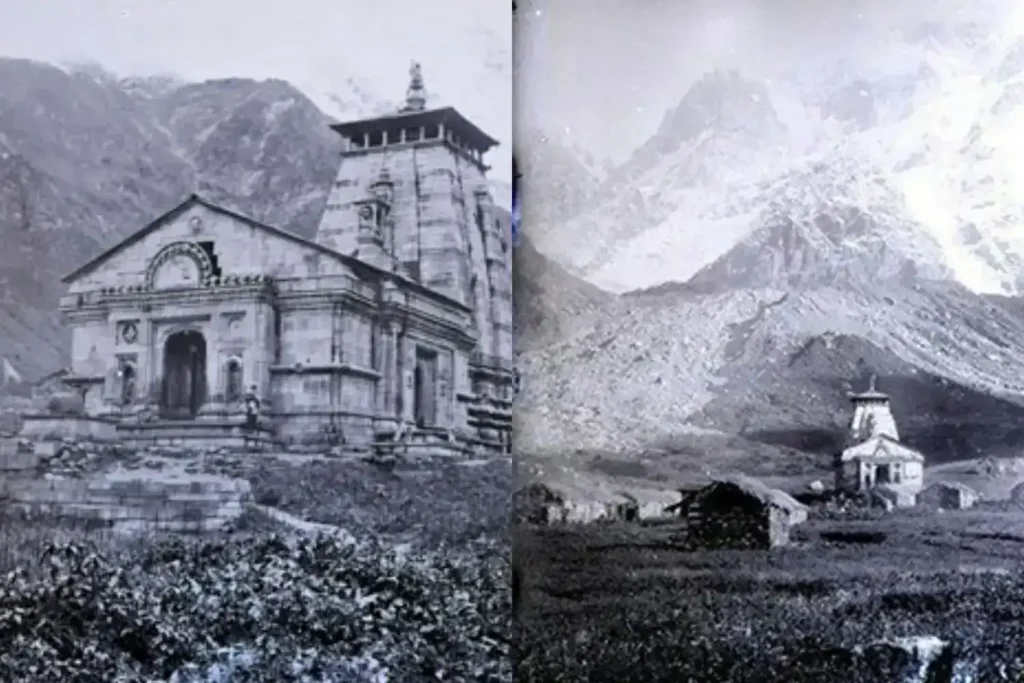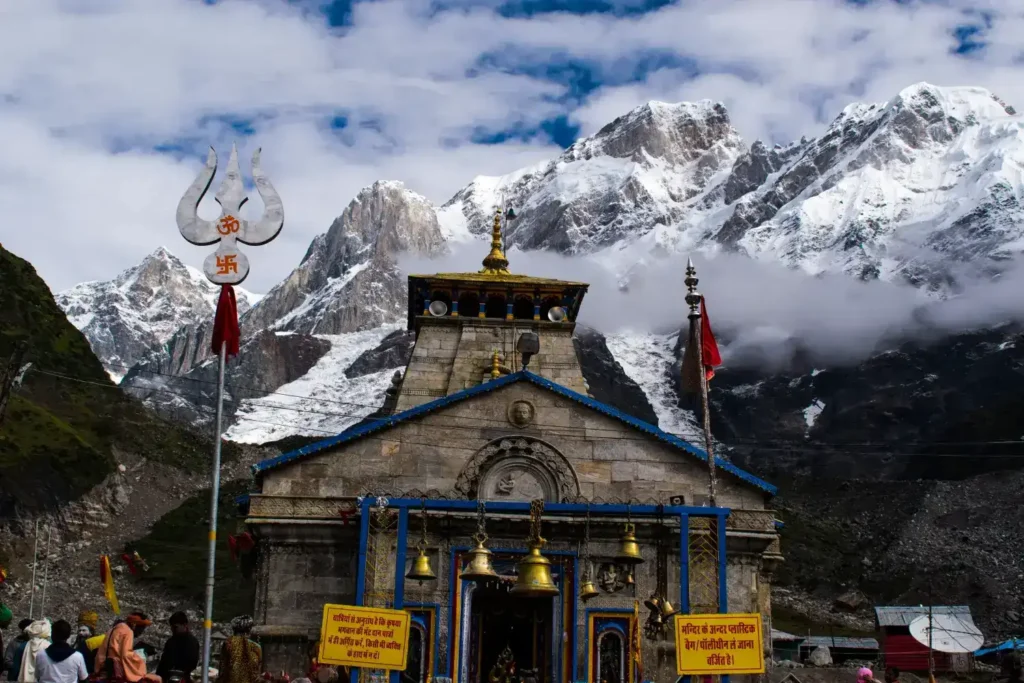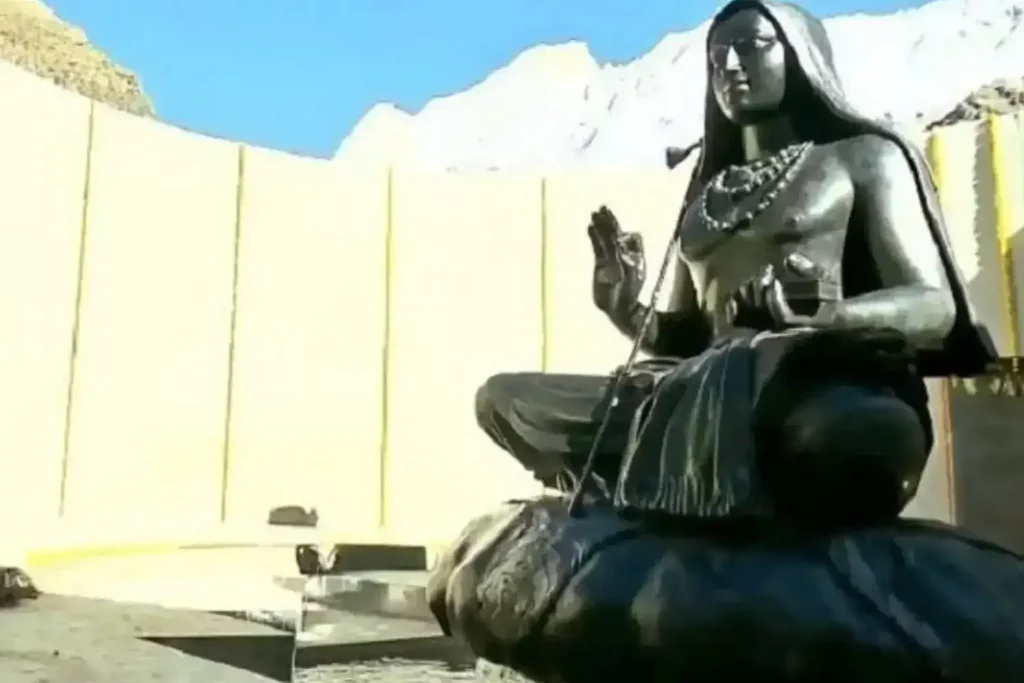KEDARNATH TEMPLE UTTARAKHAND
admin, 6 months ago, 10 min read, 150 Views

History of Shri Kedarnath Temple Uttarakhand
Kedarnath, one of India’s most well-known centers of spiritual culture, has a fascinating past to match its appeal. At an elevation of more than 11,000 feet, the Kedarnath Valley is a destination of unparalleled beauty that captivates tourists from all over the world. The focal point of everyone’s attention in this valley is the Kedarnath Temple Uttarakhand, which is surrounded by magnificent, white-topped Himalayan mountains.
In Hinduism, the Kedarnath Temple is highly revered and has endured a long history without faltering. Numerous myths, stories, and traditions surround the temple’s beginnings, and it is involved in a number of miracles. Throughout its lengthy history, Kedarnath Temple has faced many grave dangers, yet nothing has diminished its splendor, and it continues to be a vital hub for Indian culture and religion.
Origin Story & Legends

The five brothers who prevailed in the great battle of Mahabharat, known as the Pandavas, sought retribution from Lord Shiva for the deaths of their clan and relatives during the conflict. On the other hand, Lord Shiva was distancing himself from the Pandavas by posing as a bull.
The Pandavas pursued him until he vanished in Kedarnath after discovering him wandering the Himalayas in the shape of a bull. However, one of the Pandavas, Bheem, managed to get hold of the bull’s hump and held on to it. Even after the body of the bull vanished, the hump continued to plunk at the same spot. Thus, the Lingam in the temple of Kedarnath is shaped like a hump. The bull’s other components showed up in four additional places. Together, the five locations are referred to as Uttarakhand’s Panch Kedars. The Pandavas constructed the Kedarnath Temple there after Lord Shiva, pleased with their tenacity, pardoned them of their crimes.
According to another tradition, twin sages Nar and Narayan begged Lord Shiva to grant them a permanent residence on Earth in Kedarnath in exchange for their extended periods of meditation.
Additionally, it is thought that Shiva spent a considerable amount of time meditating at Kedarnath, and the temple commemorates his ancient presence.
Historical Background of Shri Kedarnath Temple

Kedarnath Temple, located amidst the Himalayan glaciers, can unquestionably trace its origins back to the prehistoric era. The most widely held view, despite the existence of other origin myths, is that the Pandava brothers, who are referenced in the Hindu epic Mahabharat, were the ones who first constructed the temple. The Hindu calendar places the date of the Pandavas’ battle at Kurukshetra in the Mahabharat epic at approximately 3100 BCE, which is also when Kedarnath Temple was built. The history of Kedarnath Temple is up for controversy, however many historians agree that the Mahabharat was fought sometime between the 10th and 8th centuries BCE. In any event, the majority of research indicates that the Kedarnath Temple could not have been before 3,000 years ago.
However, Adi Shankaracharya, an Indian vedic teacher and philosopher, constructed the reformed avatar of Kedarnath temple in the eighth century. The Char Dhams, the four principal Hindu shrines, are among the several other Hindu pilgrimage places that Adi Shakaracharya is credited with building and revitalizing.
According to certain recorded records, the temple was once constructed in the eighth century using wood and stone, but because of its unusually distant position, it fell into disrepair. Later, in the eleventh century, Raja Bhoj restored it with marbles and gray stones.
Another fascinating detail about Kedarnath Temple is that, according to many geologists, it was completely or partially covered by glacial ice for about 400 years, between 1300 and 1900 AD, during what is known as the Little Ice Age. Scientists from the Wadia Institute of Himalayan Geology in Dehradun claim that the striations and yellow lines scattered across the temple’s outside wall indicate glacial activity in the area. This demonstrates the Kedarnath temple’s exquisite architectural design.
Architecture of Shri Kedarnath Temple

The old Kedarnath Mahadev Temple has elements of both the past and the present. Because of its location between the sky-touching peaks of the Himalayan glaciers, the original construction was generously intended to survive natural disasters and harsh mountain weather in addition to being spectacular in its surroundings. Iron clamps, but no other binding material, are used to help the crudely hewn massive stone slabs that make up the temple fit together flawlessly.
The Framework
An iconic example of Nagara-style north Indian architecture is the Shri Kedarnath Mandir. The temple is supported by a solid stone plinth base. The construction will remain adamant thanks to this sturdy basis. A mandap (main hall) at the front and a garbhagriha (sanctum sanctorum) in the rear make up the temple’s overall construction. Before approaching the lofty pyramidal Garbhagriha, pilgrims congregate in the Mandap, where the Lord Shiva is worshipped in the Shikhara. Mandap is supported by slender stone pillars.A tapering roof at Garbhagriha and Mandap ensures more stability and sheds snow during heavy snowfalls.
Statues and idols
In the Garbhagriha, the idol of Shiva is housed as Kedarnath Jyotirlinga, a representation of Mahadev. The most unique Lingam, a naturally occurring conical rock that hasn’t been carved in any way, is found near Kedarnath. The idol of Nandi, the sacred bull and the vehicle of Lord Shiva is located in the Mandap, just at the entrance to Garbhagriha The inside walls of the Kedarnath temple also have numerous statues and carved images of legendary figures and goddesses that tell historical tales. Virbhadra, Draupadi, Krishna, Pandavas, and numerous others are among the statues.
Outside
The temple’s exterior is simple yet tasteful. Just beyond the Mandap (Main Hall), facing the temple, is a stone idol of Nandi that accentuates its grandeur and represents genuine devotion to the God. The temple has undergone multiple modifications despite being constructed more than 3,000 years ago. However, Adi Shankaracharya’s restructuring of the temple has helped to preserve its original form by utilizing the same materials as before.
Kedarnath Flood 2013 & Its Impacts

A destructive flash flood that struck Kedarnath in 2013 may have destroyed the temple. The Chorabari glacier behind the Kedarnath valley melted as a result of the state of Uttarakhand receiving an abnormally high amount of rainfall on June 16 and 17. This resulted in a violent flood from Chorabari Lake that swept everything in its path as it surged down to the Mandakini River. Everything was demolished and taken away in the rushing surge, including homes, shops, hotels, and highways.
A miracle occurred despite the fact that the glacier’s rushing water could have destroyed the Kedarnath Temple due to landslides and the massive loads of silt, rocks, and stones it carried. Just beyond the Kedarnath temple, a massive rock that was sliding down the slope became caught, preventing the temple from being destroyed by water and debris. Before being evacuated by the Indian Army, many people sought refuge within the Kedarnath Temple.
Water poured across both sides of the Kedarnath temple, killing everything in its path despite the shrine’s protection. More than 5,000 locals and pilgrims lost their lives in the 2013 floods, and many more went missing. Over nine million people and innumerable animals were impacted by the flood, which caused devastation to locations throughout Uttarakhand, Himachal Pradesh, and Nepal. Additionally, it had an impact on pilgrimage destinations including Badrinath, Yamunotri, and Gangotri.
One of India’s biggest calamities, the 2013 Uttarakhand floods particularly affected the Kedarnath Valley. There were hundreds of millions of dollars in recorded damages. Roads and bridges suffered damage of about $285 million, dam projects suffered about $30 million, and state tourism suffered about $195 million.
Restoration and Preservation Efforts After Flood

Following the floods in 2013, the Kedarnath Valley needed to be renovated, and its historic charm restored. The town was several feet under the debris carried by the flood. The World Bank estimated the state’s economic losses to be over 3.8 billion USD, which was actually more than the state’s yearly budget.
The shrine will not be accessible to pilgrims for the Kedarnath Dham Yatra until the following year, according to Vijay Bahuguna, the chief minister of Uttarakhand at the time, and former prime minister Manmohan Singh offered ₹1,000 crores (10 billion) in aid to handle the relief and rescue activities.
Prime Minister Narendra Modi lay the groundwork for the restoration and reconstruction of Kedarnath Temple and Kedarnath Valley (also known as Kedarpuri) in March 2014. The state received almost ₹700 crores for medium- and long-term repair.
The Project for Reconstruction
The goal of the rebuilding effort was to restore Kedarnath’s ecological, aesthetic, and religious holiness. Prior to the flood, the Kedarnath temple was encircled by disorganized structures and clogged streets, making the township unsightly and limiting the temple’s visibility.
A broad walkway is planned for an approach from a circular tourist arrival plaza at the base to the temple at the summit as part of the Kedarnath restoration project. The approach features broad steps with several landings that are paved with stones that have been cut from rocks that were placed throughout the valley’s natural landscape.
Because of this architecture, pilgrims can travel to the temple in luxury and take in the stunning vista of the shrine set against the ever-present snow-capped mountains. A non-vehicular zone has been established for the entire corridor.
The Trekking Path
Fourteen kilometers of the pilgrimage route to the shrine of Kedarnath had been devastated by the water. As a result, a new walking path is established along the Mandakini River’s left bank. To link the trekking trail with Rambara hamlet, a new bridge is constructed across the Mandakini River.
Flood Defense
Behind the temple and the ghats, a three-layer protection wall is built to deflect the river’s flow and withstand the force of swift currents. Along the Mandakini and Saraswati rivers, retaining walls are built to redirect overflow to approved routes in the event of a future flash flood.
New Progress at the Dham of Shri Kedarnath

Adi Shankaracharya Samadhi
Just below the Kedarnath Temple is the Samadhi of the renowned Indian philosopher and scholar Adi Shankaracharya. Overlooking a Shri Yantra, a statue of Adi Guru Shankaracharya stands twelve feet tall. In addition to achieving nirvana at Kedarnath, Adi Shankaracharya was the one who restored and constructed the temple there in the eighth century. Adi Shankaracharya Samadhi represents India’s spirituality, history, and legacy.
Caves for Meditation
Meditation caverns called Kedarnath Cave or Rudra Gufa are intended for spiritual travelers who wish to enjoy some quiet alone in this well-known location. These caves, which are only a kilometer from Kedarnath temple, are ideal for spiritual activities like yoga and meditation. Built in the typical Garhwal manner, Kedarnath Caves serves as a lodging alternative that may be reserved via the GMVN website. The cave contains a bed, an associated toilet, water, electricity, and CCTV surveillance, but it can only hold one person. An attendant is always available at the cave to assist.
The use of retaining walls and ghats
In order to protect the legacy and prevent future damage, 350-meter-long stone embankments and ghats were built during the 2013 floods. These are made for puja and to indicate the river’s course on both the eastern and western banks of the Saraswati and Mandakini rivers. In addition, the retaining wall’s use will lessen soil erosion at the location. Alongside these embankments are cafeterias, restrooms, purohit quarters, dressing rooms, and a pavilion for common guests. These will also be used for artwork, murals, and paintings.
Biodegradable Toilets on the Trek Route to Kedarnath
With hundreds of bio- digesting toilets constructed by DRDO that use bacterial action to convert the contents into water and air, the Kedarnath Dham is now a more convenient and environmentally friendly place to visit.
Management of Waste in the Kedarnath Area
Food waste, temple garbage, biomedical waste, building waste, and other waste issues are being addressed by the Kedarnath authorities. To improve waste management, several organizational systems are being implemented, including the Micro Auto Gasification System, Material Recovery Facility, and Recycle Deposit Refund. To properly combat wastes, a 5R method—a combination of 3R and 5R methods—is employed.
System for Traffic Management
In order to prevent congestion during peak rush, the Kedarnath shrine now features walking pathways and efficient traffic management. Shri Kedarnath Mandir is open to the public both physically and metaphorically, regardless of its architectural design. With benches, lights, trash cans, plants, and sculptures, these streets now have specific rules.
Digitalization and IT Connectivity
Through radio frequency-based networks, the Kedarnath Valley offers rudimentary local internet access, including WiFi and outdoor audio systems like the “Smart Public Address System.”
System for Disaster Management
Given the site’s susceptibility to earthquakes and floods, an efficient disaster management system is necessary. SOPs have also been established for risk control, such as identification, training, and retraining programs. Furthermore, appropriate civil features such as embankments and retaining walls have been installed. In the event of a calamity, the element also contains plans and procedures for evacuation, disaster relief, and refuge that can house 28,000 people. Through the use of a weatherproof Smart Public Addressal System, loudspeakers have been integrated into the site.
Conclusion
Kedarnath is a symbol of unshakable faith, devotion, and spiritual enlightenment in addition to being a place of pilgrimage. It has great religious importance in Hinduism as one among the twelve Jyotirlingas. The temple is a genuinely heavenly location because of its close relationship with Lord Shiva, its historical associations with the Pandavas, and its stunning Himalayan setting.
Kedarnath is robust in the face of natural disasters, drawing thousands of pilgrims each year who seek Shiva’s blessings and moksha (freedom). Every visitor feels a distinct sense of fulfillment and tranquility, whether it is from the soul-soothing prayers or the strenuous hike.
Related FAQs
When is the ideal time of year to travel to Kedarnath?
April through June and September through November are the ideal times of year to visit Kedarnath. You may trek to Kedarnath with ease during these months, and the weather is lovely. However, because of the intense snowfall throughout the winter, the temple is closed.
How can I get to Kedarnath?
At 3,583 meters above sea level, Kedarnath is reachable by foot or by helicopter. The closest train station is at Rishikesh, while the closest airport is Jolly Grant Airport in Dehradun. From there, you can get to Gaurikund, the starting point for the journey to Kedarnath, via bus or cab.
What is the Kedarnath hike route?
The 16-kilometer journey to Kedarnath takes about six to seven hours. Beginning at Gaurikund, the hike route winds through picturesque waterfalls and forests. You must be physically fit to finish the hike because it is steep in some parts. If you don’t want to trek, you can instead rent a palanquin or a mule.
Can children and senior folks travel to Kedarnath?
Yes, both youngsters and senior folks are welcome to visit Kedarnath. They must, however, be in good physical condition and see a physician before making travel plans. To get to Kedarnath, you can rent a mule or a palanquin if necessary.
Which lodging alternatives are available in Kedarnath?
Kedarnath offers a variety of lodging choices, from luxurious campgrounds to low-cost hotels. Additionally, you can stay in the affordable government guest houses. However, at the busiest times of the year, it is best to reserve your lodging in advance.
